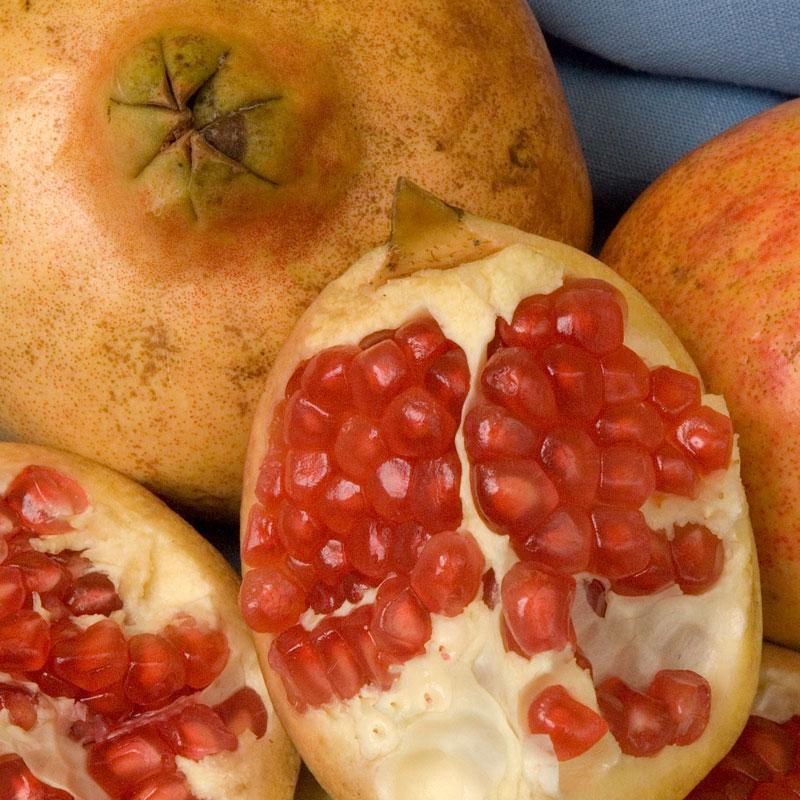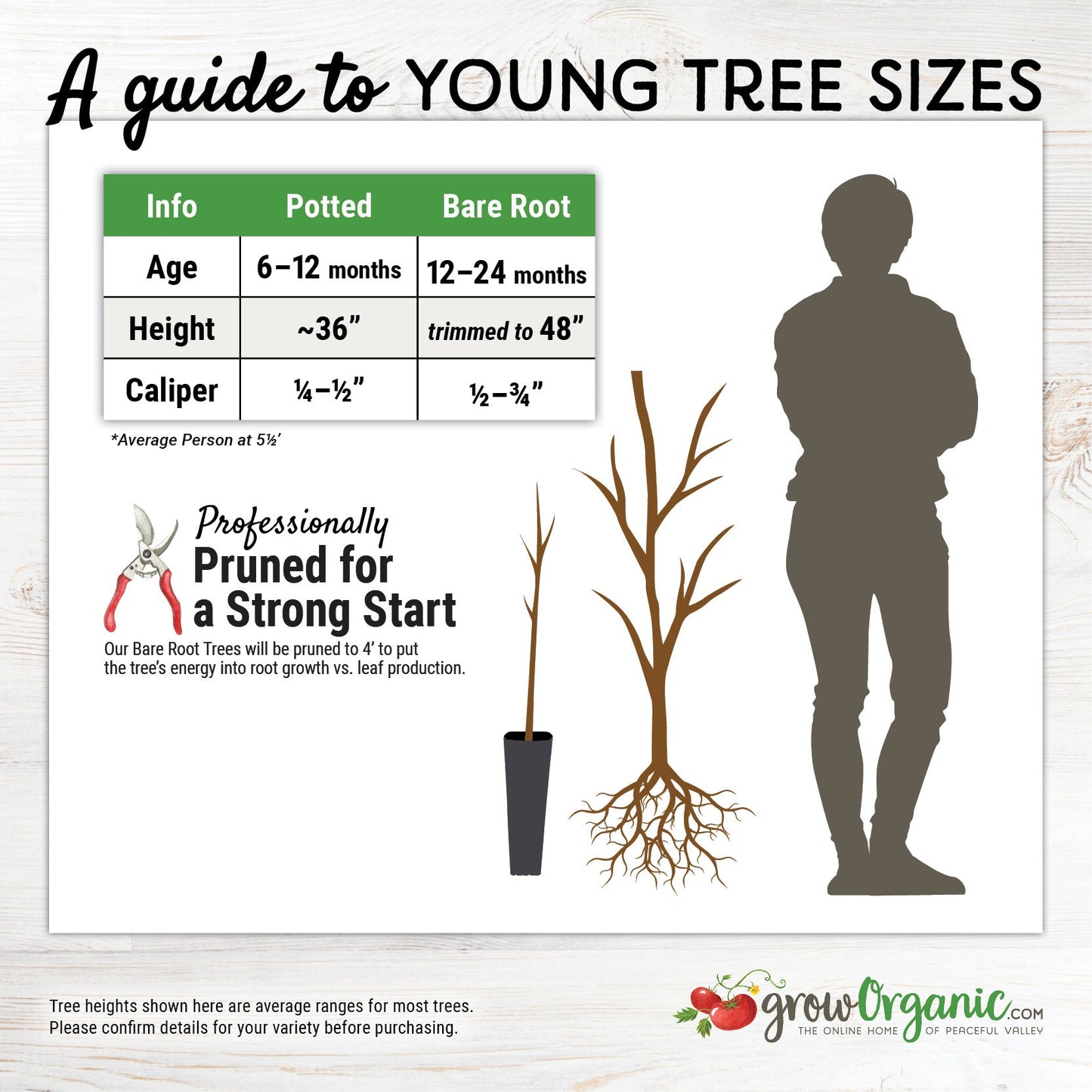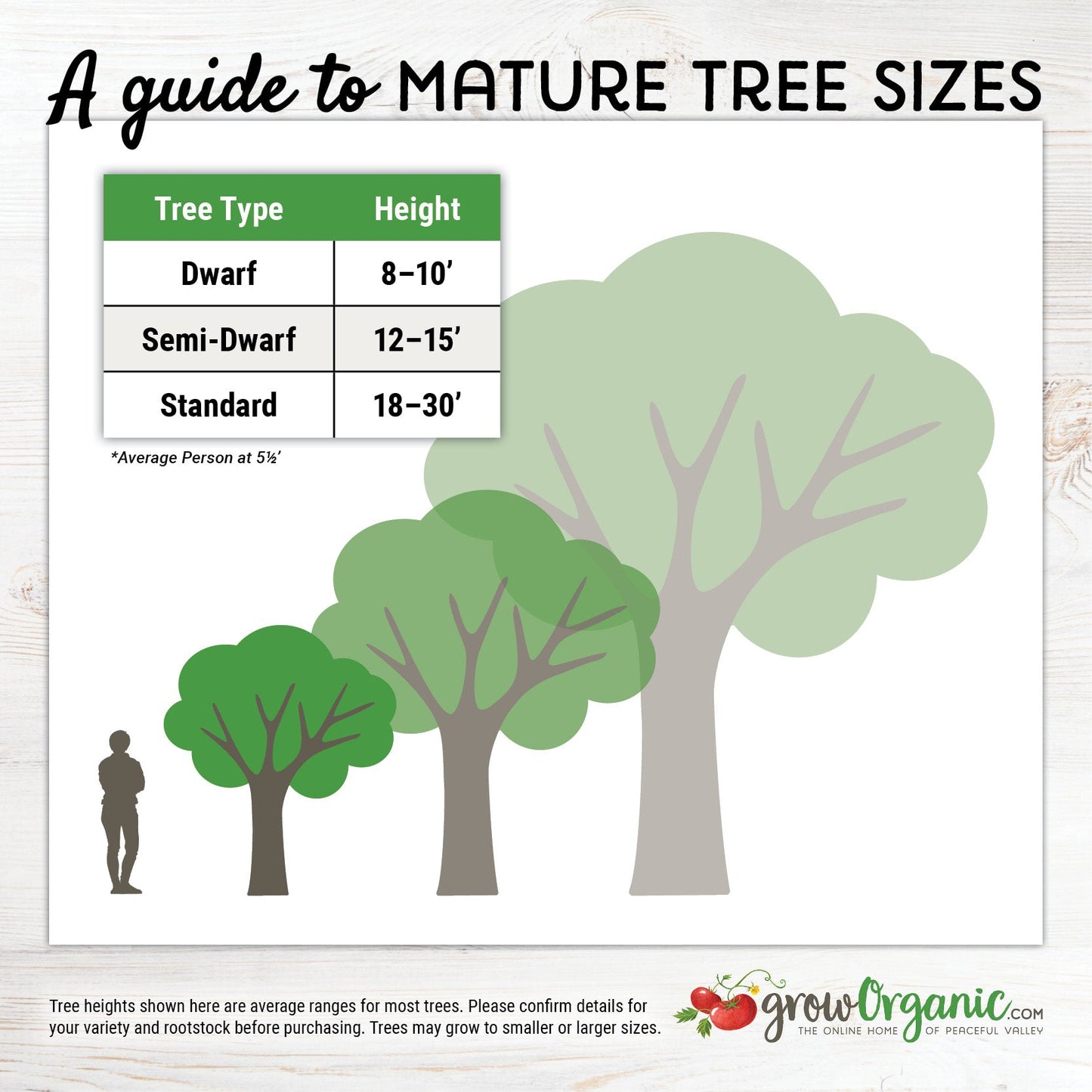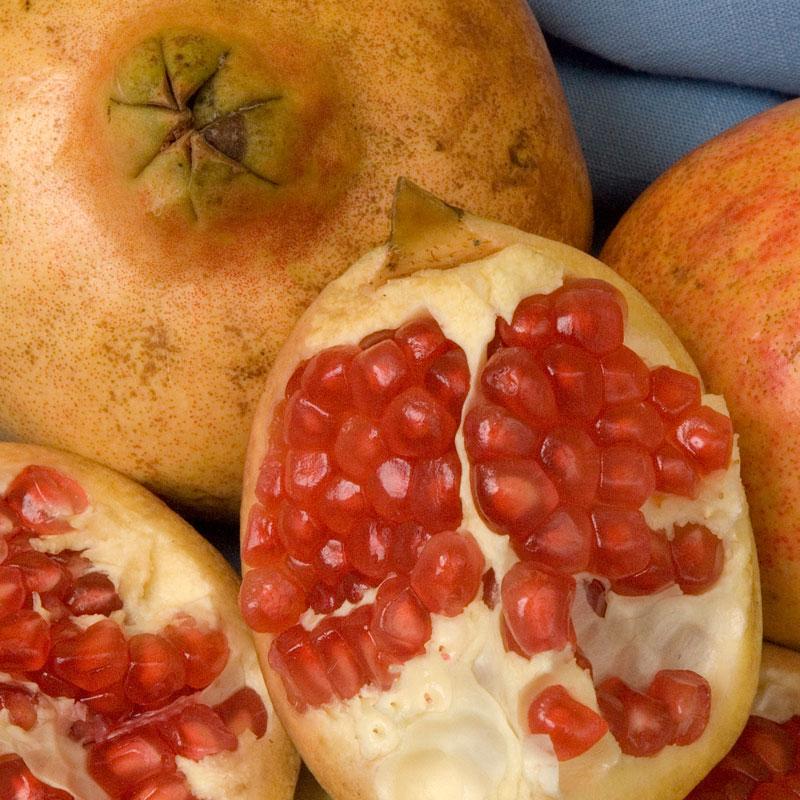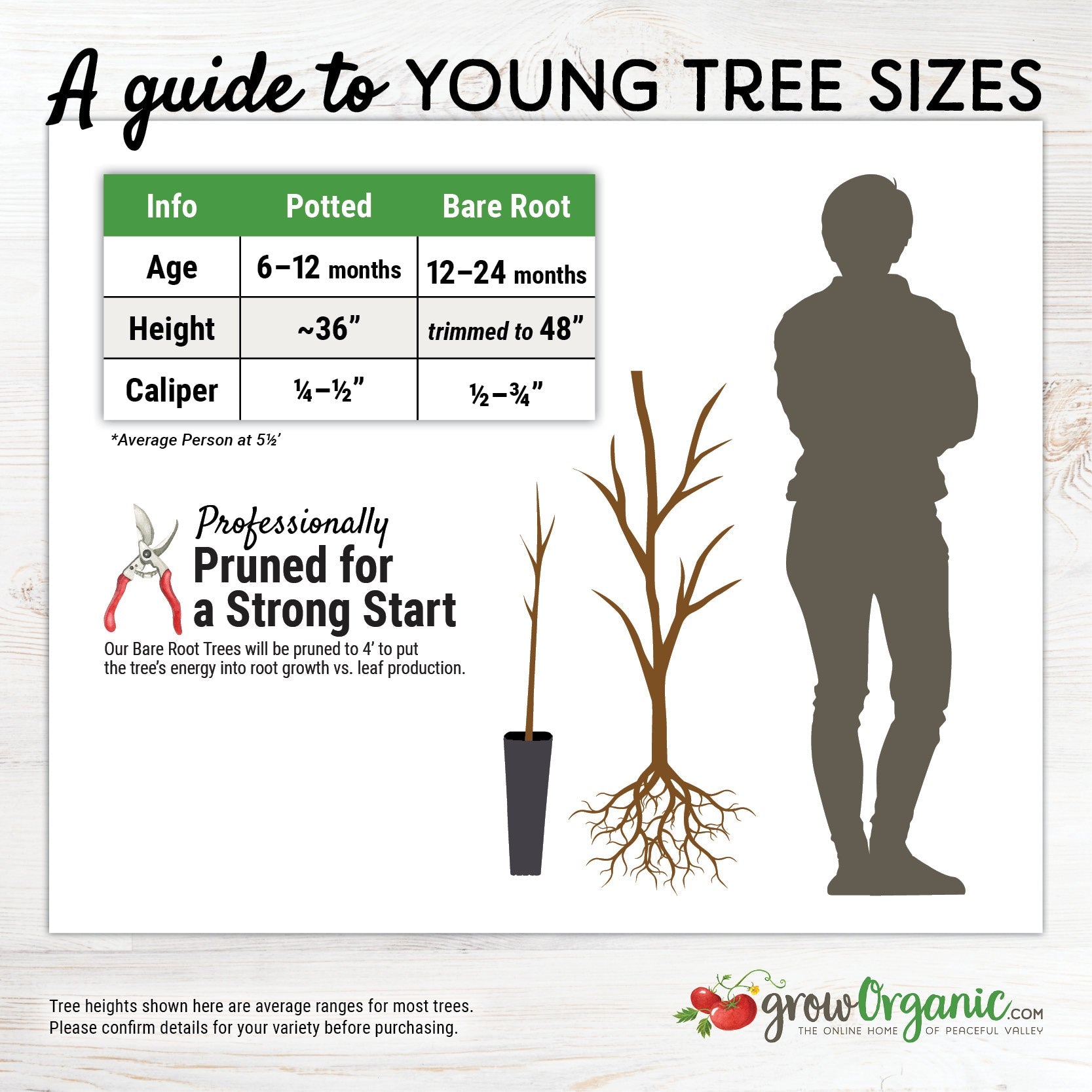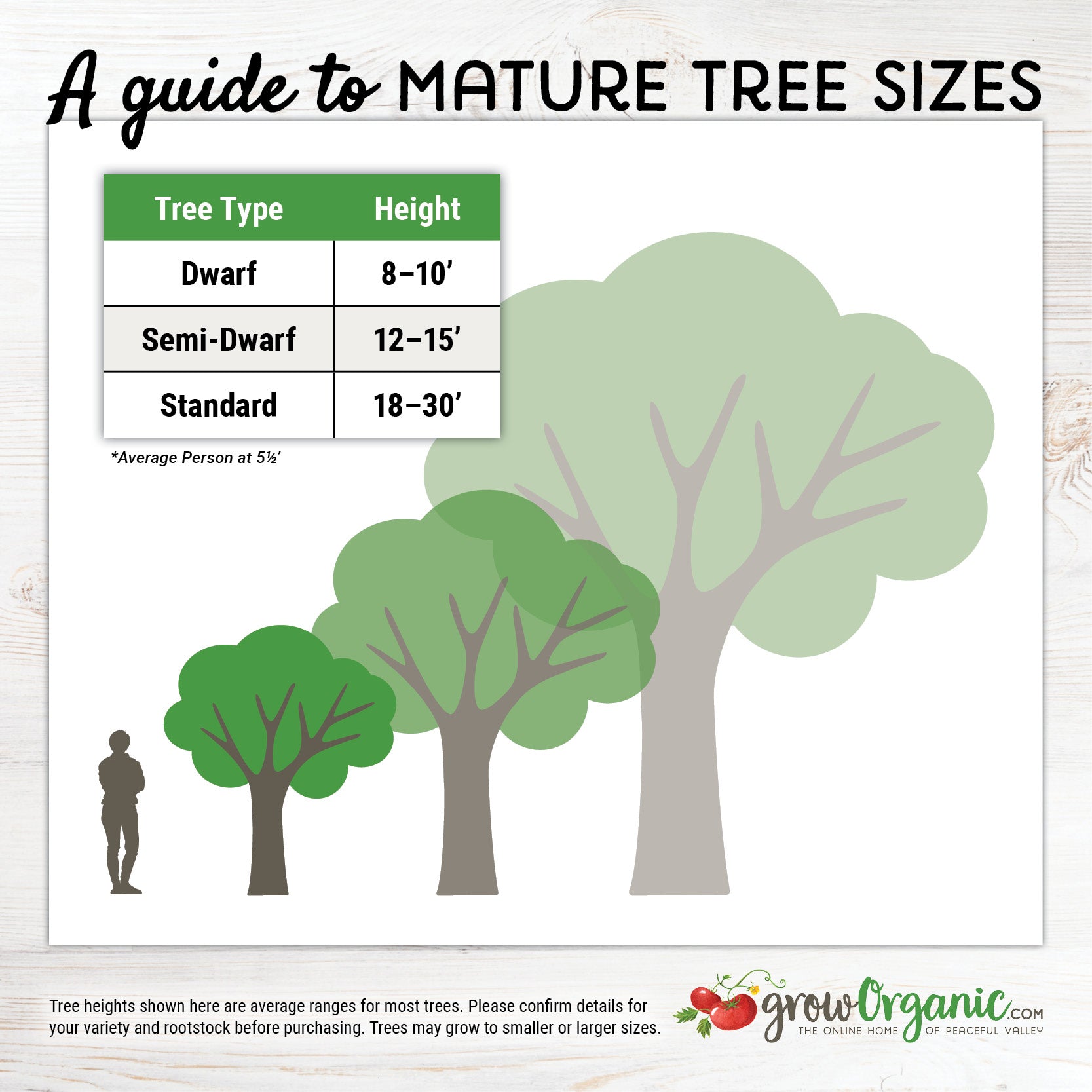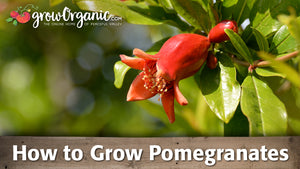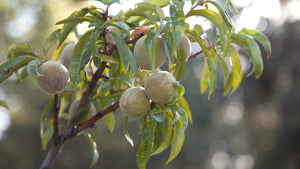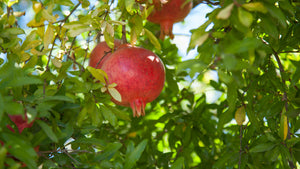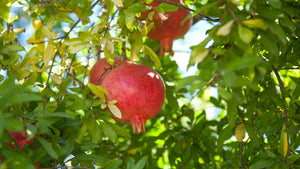Item Number: FT225
Sweet Pomegranate Tree
Sweet Pomegranate Tree
Makes Pink Juice!
Potted Tree
- Zones: 8-10
- Chill hours: 100
- Harvest: September 8 - October 13
- Looks: Somewhat greenish with a red blush and pink juiced.
- Personality: Much sweeter than many other cultivars.
- Facts of note: Pomegranates are not grafted onto any rootstock, so in areas where it gets cold enough to freeze the tops of the plants back sometimes, they still come back and produce the same fruit. Hummingbirds love the pomegranate flowers. Responds well to being grown as an espalier and in containers. Unsplit fruit stores for up to 2 months. Pomegranates are nice ornamentals with showy orange red spring blossoms. Bears at an early age and is productive. Widely adapted and can tolerate cool summer climates.
- Pollination: Self-pollinated.
The Sweet Pomegranate Tree: A Jewel of the Garden
The Sweet Pomegranate tree, scientifically known as Punica granatum, is a remarkable and cherished addition to any garden. With its vibrant, ruby-red fruit and lush green foliage, this tree not only enhances the aesthetics of your outdoor space but also offers a plethora of health benefits and culinary delights. In this comprehensive guide, we will explore the various facets of the Sweet Pomegranate tree, from its origins to cultivation and its many uses.
A Rich History
The Sweet Pomegranate tree has a rich history dating back thousands of years. Originating in the Middle East, it has been cultivated in regions like Iran, India, and the Mediterranean for millennia. The pomegranate fruit holds a significant place in various cultures and mythologies, often symbolizing fertility, abundance, and prosperity. Its distinctive appearance and symbolism have made it a popular motif in art, literature, and religious texts throughout history.
Characteristics of the Sweet Pomegranate Tree
The Sweet Pomegranate tree is a deciduous shrub or small tree that typically reaches a height of 10 to 20 feet. It boasts glossy, lance-shaped leaves that are a rich, deep green, providing an attractive backdrop for the vibrant fruits. During the spring and early summer, the tree graces the garden with striking orange-red, trumpet-shaped flowers, which are not only visually appealing but also attract pollinators like bees.
Fruitful Bounty: Pomegranates
The main highlight of the Sweet Pomegranate tree is, of course, its fruit. Pomegranates are known for their distinctive appearance, with a tough, leathery outer skin that protects the clusters of juicy, ruby-red arils (seed sacs) inside. These arils are the edible part of the fruit, bursting with a sweet and slightly tart flavor that is both refreshing and delicious.
Cultivating Sweet Pomegranates
Growing a Sweet Pomegranate tree in your garden is a rewarding endeavor. They thrive in regions with hot, arid summers and mild winters. Here are some key considerations for successful cultivation:
Location: Plant your Sweet Pomegranate tree in a sunny spot with well-drained soil. Full sun is essential for fruit production.
Watering: While these trees are relatively drought-tolerant, consistent watering during the growing season is necessary for optimal fruit development. However, be cautious not to overwater, as pomegranates are susceptible to root rot in waterlogged soil.
Pruning: Regular pruning helps maintain the shape of the tree and encourages fruit production. Remove any dead or crossing branches to improve air circulation.
Fertilization: Pomegranate trees benefit from annual fertilization with a balanced, slow-release fertilizer in the spring.
Health Benefits and Culinary Uses
Pomegranates are not only delightful to the taste buds but also offer a range of health benefits*. They are packed with antioxidants, vitamins, and minerals, making them a nutritious addition to your diet. Research suggests that pomegranates may help lower blood pressure, reduce the risk of heart disease, and have anti-inflammatory properties.
In the kitchen, pomegranates are incredibly versatile. You can enjoy them fresh, add them to salads for a burst of flavor and color, or use their juice to make sauces, dressings, and beverages. Pomegranate seeds are also a delightful garnish for desserts and cocktails.
The Sweet Pomegranate tree is a true gem in the world of gardening. With its fascinating history, stunning appearance, and delicious fruits, it adds both beauty and functionality to your outdoor space. Whether you're a seasoned gardener or a novice, cultivating a Sweet Pomegranate tree can be a rewarding experience, offering not only visual pleasure but also a bounty of health benefits and culinary delights. So, consider adding this remarkable tree to your garden and savor the sweetness it brings to your life.
Visit our Fruit Tree Central for a listing of all our fruit tree videos and articles.
Visit Tree Characteristics for a listing of all our fruit & nut tree growing characteristics.
* Not medical advice. See a physicial for details.


Check Your Zone Compatibility:
Compatible with your zone.
Growing Zone for
,

Our Guarantee To You
Since 1976, we've served our customers at every stage of growing. Please contact us at any time. We are happy to support and assist you.
Description
Description
Potted Tree
- Zones: 8-10
- Chill hours: 100
- Harvest: September 8 - October 13
- Looks: Somewhat greenish with a red blush and pink juiced.
- Personality: Much sweeter than many other cultivars.
- Facts of note: Pomegranates are not grafted onto any rootstock, so in areas where it gets cold enough to freeze the tops of the plants back sometimes, they still come back and produce the same fruit. Hummingbirds love the pomegranate flowers. Responds well to being grown as an espalier and in containers. Unsplit fruit stores for up to 2 months. Pomegranates are nice ornamentals with showy orange red spring blossoms. Bears at an early age and is productive. Widely adapted and can tolerate cool summer climates.
- Pollination: Self-pollinated.
The Sweet Pomegranate Tree: A Jewel of the Garden
The Sweet Pomegranate tree, scientifically known as Punica granatum, is a remarkable and cherished addition to any garden. With its vibrant, ruby-red fruit and lush green foliage, this tree not only enhances the aesthetics of your outdoor space but also offers a plethora of health benefits and culinary delights. In this comprehensive guide, we will explore the various facets of the Sweet Pomegranate tree, from its origins to cultivation and its many uses.
A Rich History
The Sweet Pomegranate tree has a rich history dating back thousands of years. Originating in the Middle East, it has been cultivated in regions like Iran, India, and the Mediterranean for millennia. The pomegranate fruit holds a significant place in various cultures and mythologies, often symbolizing fertility, abundance, and prosperity. Its distinctive appearance and symbolism have made it a popular motif in art, literature, and religious texts throughout history.
Characteristics of the Sweet Pomegranate Tree
The Sweet Pomegranate tree is a deciduous shrub or small tree that typically reaches a height of 10 to 20 feet. It boasts glossy, lance-shaped leaves that are a rich, deep green, providing an attractive backdrop for the vibrant fruits. During the spring and early summer, the tree graces the garden with striking orange-red, trumpet-shaped flowers, which are not only visually appealing but also attract pollinators like bees.
Fruitful Bounty: Pomegranates
The main highlight of the Sweet Pomegranate tree is, of course, its fruit. Pomegranates are known for their distinctive appearance, with a tough, leathery outer skin that protects the clusters of juicy, ruby-red arils (seed sacs) inside. These arils are the edible part of the fruit, bursting with a sweet and slightly tart flavor that is both refreshing and delicious.
Cultivating Sweet Pomegranates
Growing a Sweet Pomegranate tree in your garden is a rewarding endeavor. They thrive in regions with hot, arid summers and mild winters. Here are some key considerations for successful cultivation:
Location: Plant your Sweet Pomegranate tree in a sunny spot with well-drained soil. Full sun is essential for fruit production.
Watering: While these trees are relatively drought-tolerant, consistent watering during the growing season is necessary for optimal fruit development. However, be cautious not to overwater, as pomegranates are susceptible to root rot in waterlogged soil.
Pruning: Regular pruning helps maintain the shape of the tree and encourages fruit production. Remove any dead or crossing branches to improve air circulation.
Fertilization: Pomegranate trees benefit from annual fertilization with a balanced, slow-release fertilizer in the spring.
Health Benefits and Culinary Uses
Pomegranates are not only delightful to the taste buds but also offer a range of health benefits*. They are packed with antioxidants, vitamins, and minerals, making them a nutritious addition to your diet. Research suggests that pomegranates may help lower blood pressure, reduce the risk of heart disease, and have anti-inflammatory properties.
In the kitchen, pomegranates are incredibly versatile. You can enjoy them fresh, add them to salads for a burst of flavor and color, or use their juice to make sauces, dressings, and beverages. Pomegranate seeds are also a delightful garnish for desserts and cocktails.
The Sweet Pomegranate tree is a true gem in the world of gardening. With its fascinating history, stunning appearance, and delicious fruits, it adds both beauty and functionality to your outdoor space. Whether you're a seasoned gardener or a novice, cultivating a Sweet Pomegranate tree can be a rewarding experience, offering not only visual pleasure but also a bounty of health benefits and culinary delights. So, consider adding this remarkable tree to your garden and savor the sweetness it brings to your life.
Visit our Fruit Tree Central for a listing of all our fruit tree videos and articles.
Visit Tree Characteristics for a listing of all our fruit & nut tree growing characteristics.
* Not medical advice. See a physicial for details.
About Pomegranates: Glossy-leaved, ornamental and long-lived tree with showy orange-red blossoms in late spring. Pomegranates are native to Iran and India and have been cultivated in the arid regions of the world since antiquity. They love desert climates with hot summers and cold winters they have been known to grow as far north as Utah and Washington D.C. but they rarely fruit in these latitudes. When planting, cut back the top half of the tree and cut side limbs back to 3-6” to prevent desiccation and stress. A pomegranate can reach 20-30' in maturity, but is more commonly seen at 12-16'. Suitable to espalier. Pomegranates do not like to be planted as bare-roots and are difficult to establish, so we sell these No. 1 size trees (2’ to 3’) in pots to enhance their survival rate. Trees are 1 year old, and should begin to fruit in 2-3 years.
Please Note: Although most of our bare-root trees arrive to our warehouse in mid-December, there are a few varieties that will not arrive until mid-January. If you order any of those varieties along with varieties that arrive in mid-December, your order will be delayed for shipment until mid-January. If you'd like us to split your shipments, please contact us at (800) 784-1722 or orderdesk@groworganic.com. Additional shipping charges will apply.
Shipping Information
Shipping Information
Cannot ship to the following states: AK, HI, PR, VI, GU
Cannot ship via USPS.
Cannot ship via SmartPost.
Shipping Weight: 5.5 lb
Dimensions: 35.9"L x 3.9"W x 3.9"H
Features
Features
- Flavor Pick
- Potted
- Self-fruitful
- Suited to Warmer Climates
Characteristics
Characteristics
Planting & Care
Planting & Care
Useful Information
Useful Information
Guarantee
Guarantee
We guarantee the perishable items we sell to be in good, viable condition when we sell them. Perishable items include, but are not limited to, garlic bulbs, flower bulbs, seed potatoes, onion sets & transplants, potted or bare root trees, vegetable crowns, etc. If your perishable item arrives in substandard condition, take photographs and please contact us within 3 days of the purchase date (or delivery date) and we will provide you with a refund of the purchase price (excluding shipping costs), or a replacement. Accordingly, we urge you to open any boxes marked as ""Perishable"" immediately upon receiving them and inspect the shipment thoroughly (do not crack open heads of garlic, we do not accept claims on cracked garlic). Because some perishable items can deteriorate very quickly, we cannot accept any claims beyond the 3-day time frame as it becomes too difficult to determine if these items were delivered in substandard condition, or if they turned into such substandard condition because of having been improperly cared for or stored once delivered.
Share
